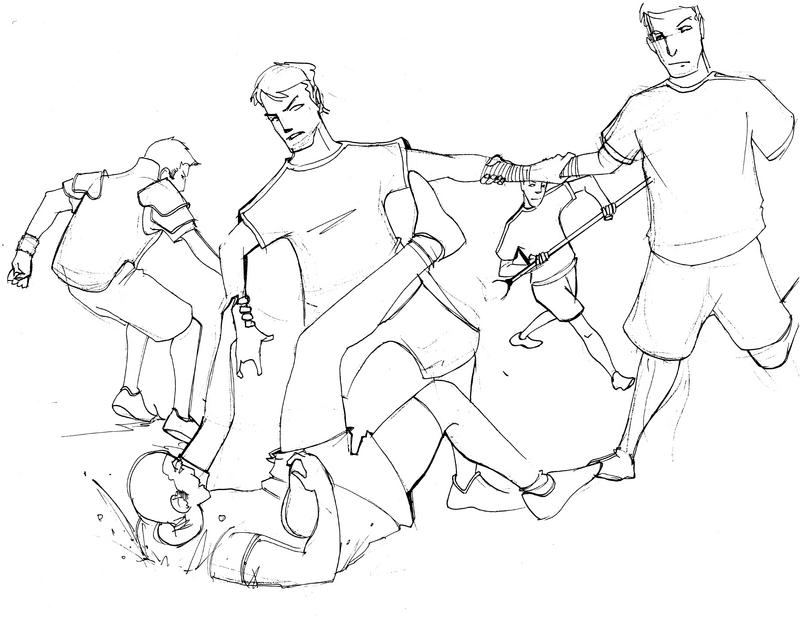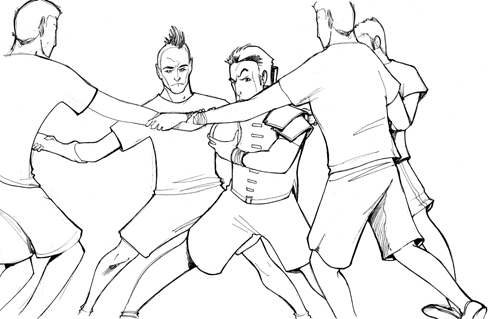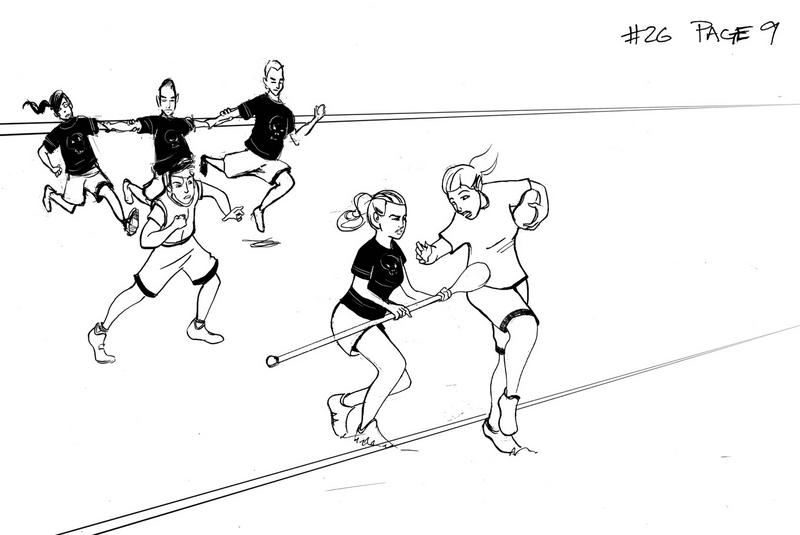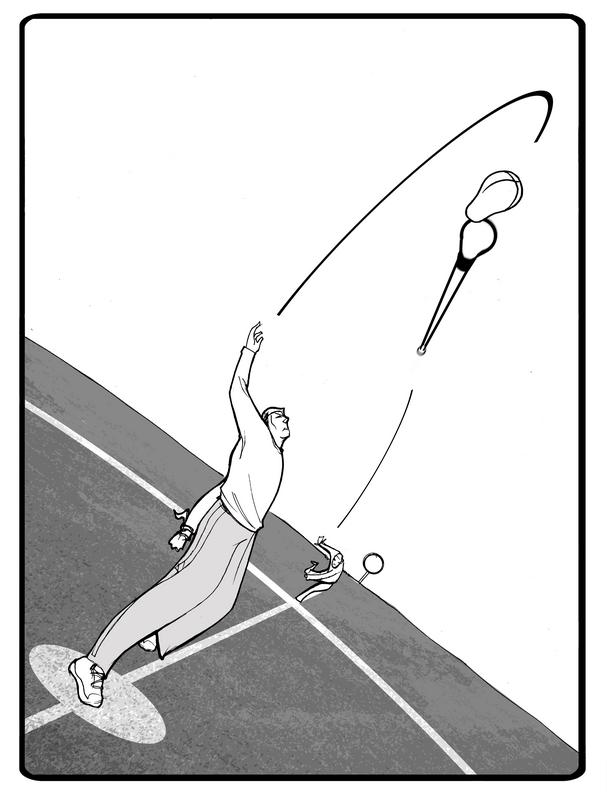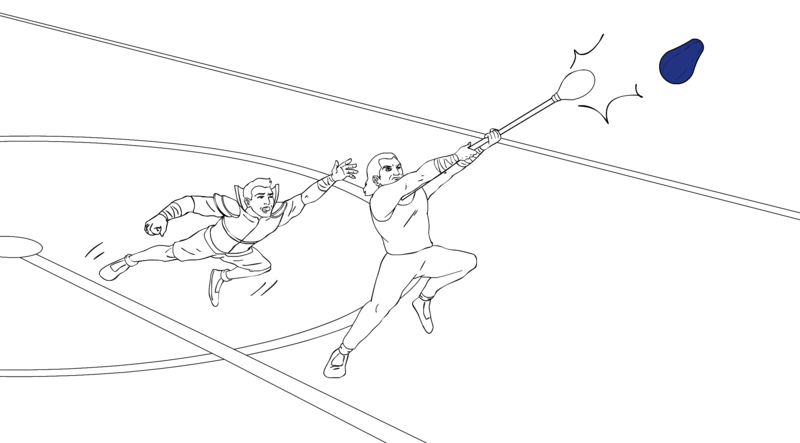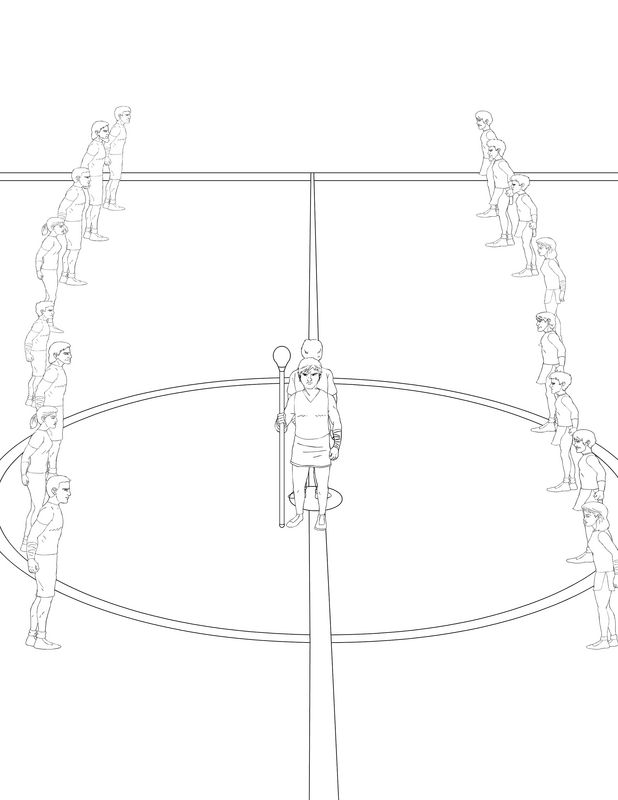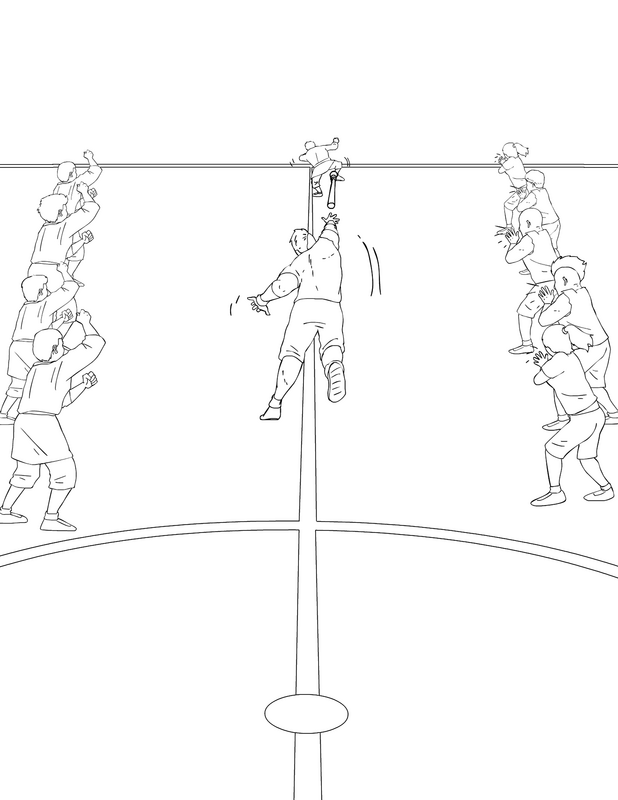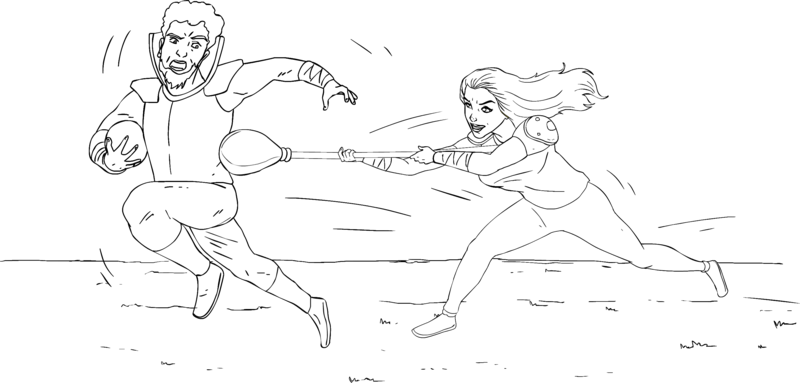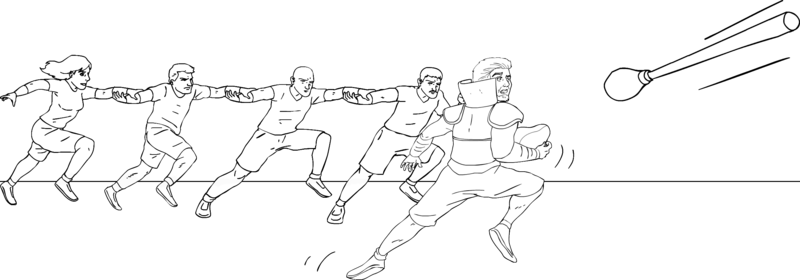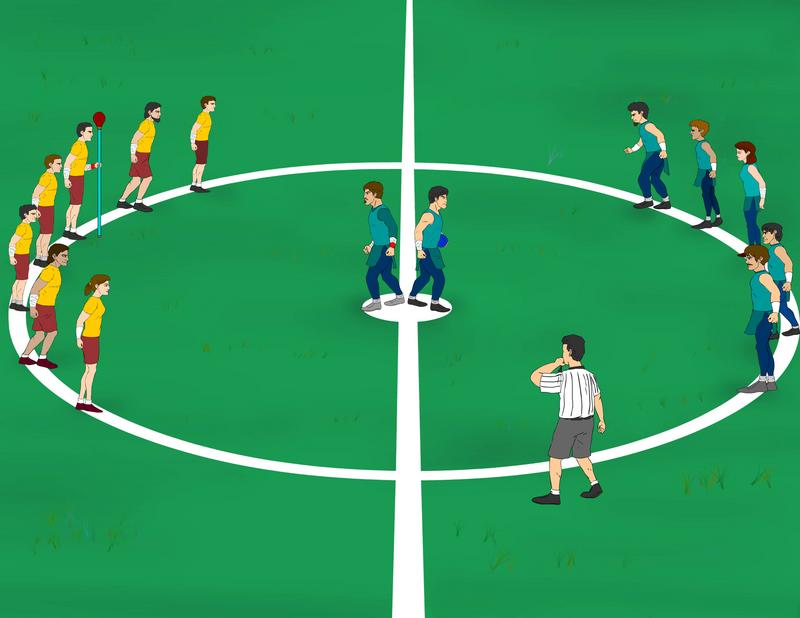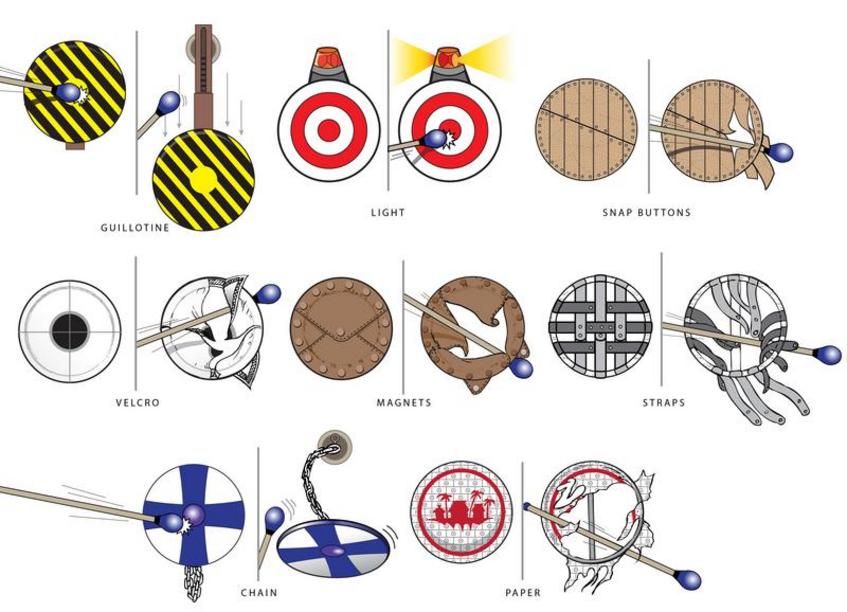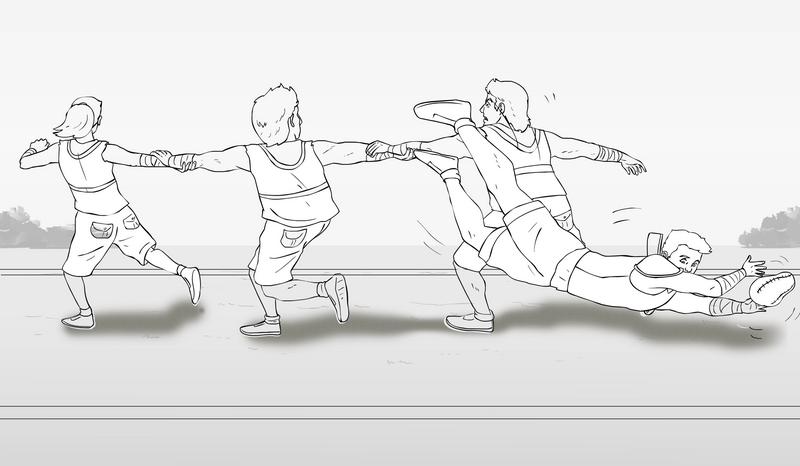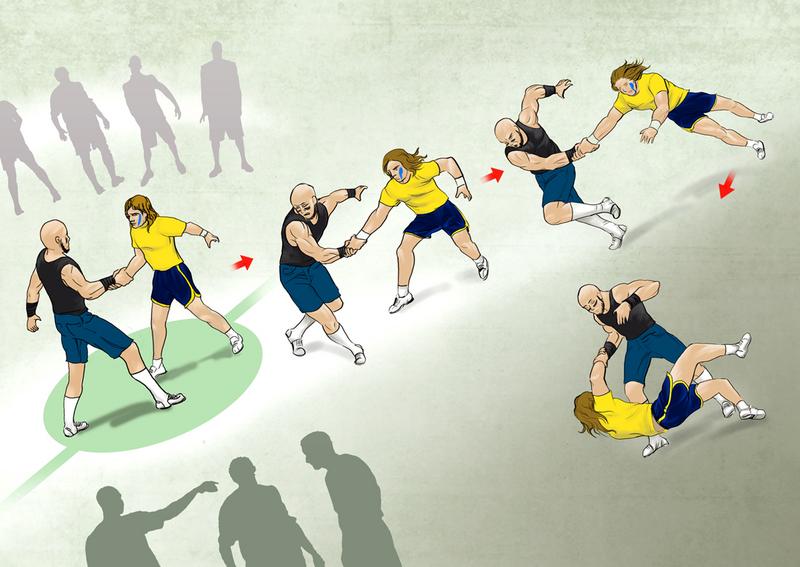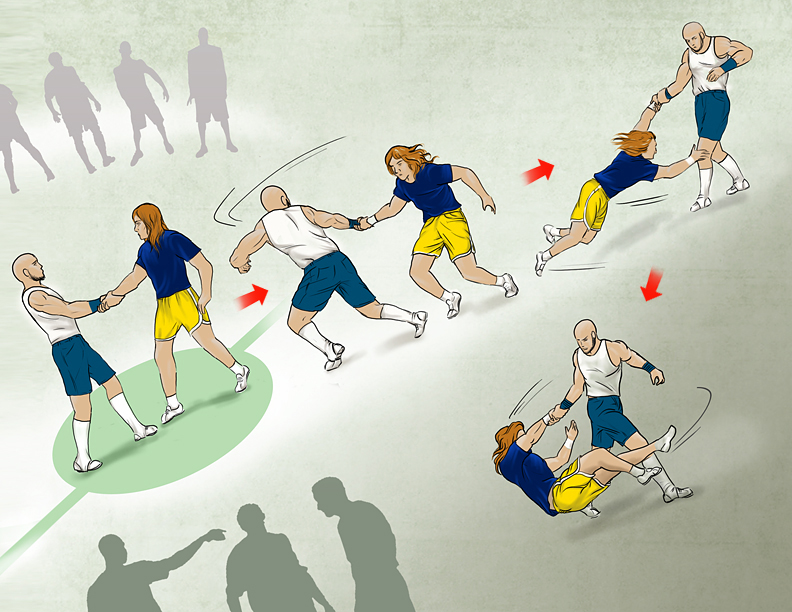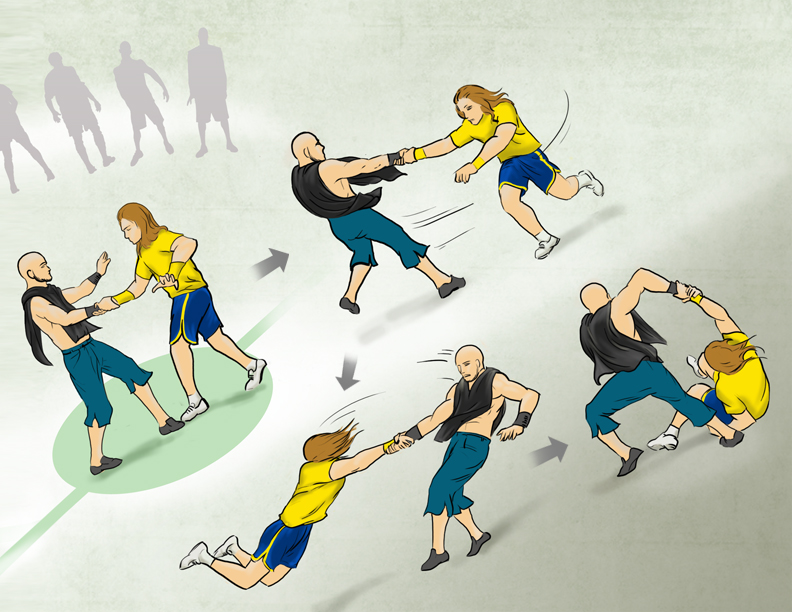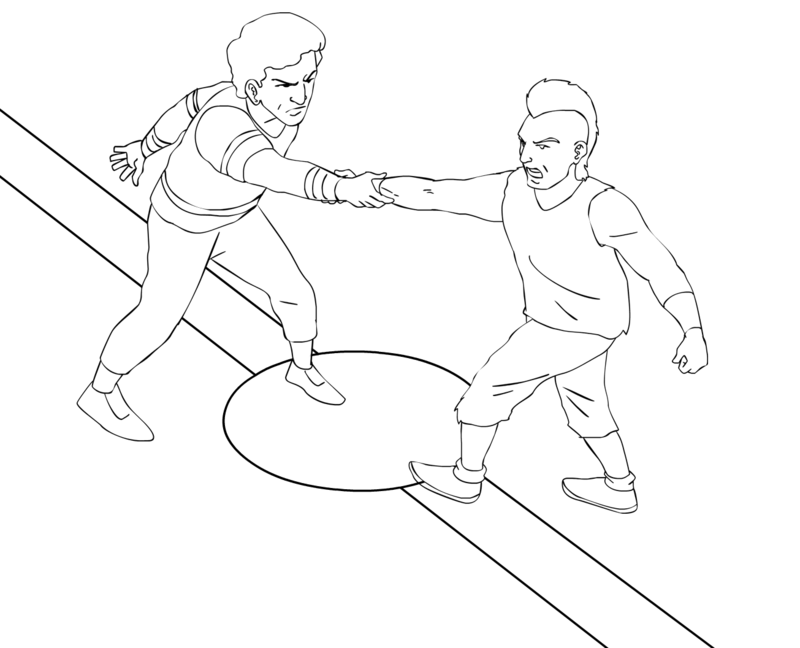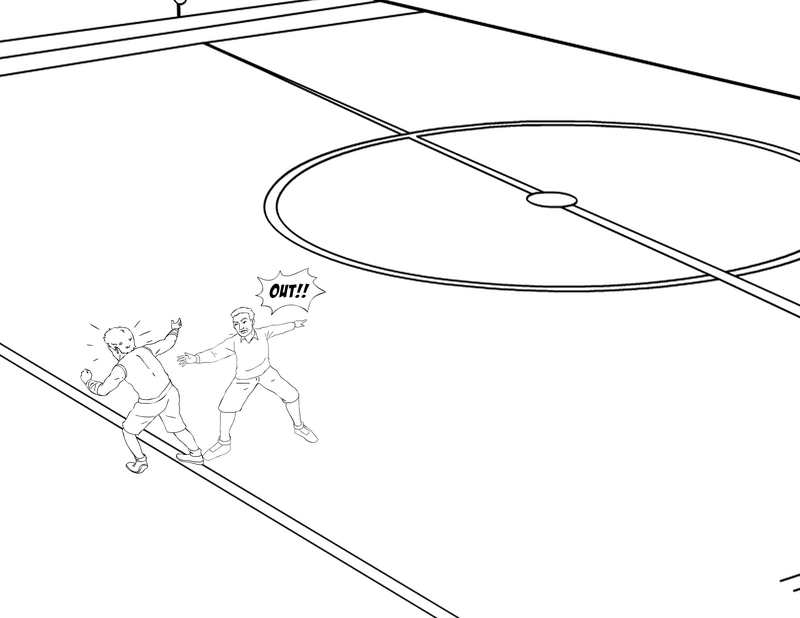The Rule Book Page Seven (7)
You Are On Page Seven (7)
Rules of Engagement:
The game begins.
The game is poised and ready to begin when all team players are positioned at their respective starting points and the Team Leader who has possession of the polearmball is signaled (Gong is sounded) so that he/she may now throw the polearmball to the Runner in the Midfield Circle.
The other members from each team who are neither the first Runner nor the first Polearmist must remain behind the Delivery Lines at opposite ends of the field until the polearmball is caught by the Runner. If the ball is successfully caught by the Runner then the players from both teams who are behind the Delivery Lines may advance to the Limit Lines and wait for the outcome of the face-off between the Polearmist and the Runner. If the Runner fails to catch the ball due to a miss or fumble then the opposing team is awarded one (1) point. After a failed catch the sides reverse and a new Runner and Polearmist is chosen by the respective Team Leaders.
The team which runs the ball first must select a Runner first after which the other team selects their Polearmist. The Runner is always selected first and the Polearmist is always selected second by the other Team Leader.
If a failed catch by the Runner is due to a successful interception by the Polearmist whereby the Polearmist jousts or spears the polearmball then the Polearmist’s team scores two (2) points for spearing or three (3) points for jousting the polearmball. The sides then reverse choosing a new Runner and new Polearmist. The teams restart at opposite sides of the field from the last round.
Rotation:
All players must play the part of Polearmist and Runner. All players must take a turn as the game progresses to be the Polearmist and the Runner who starts the round. The rotation passes from one player to another until all players have taken a turn without repeating their turn. The Team Leaders will always go last in the rotation. The event when the Team Leaders go head to head signals the end of the rotation of the players. In the subsequent scrimmage or run the Team Leaders may select a new order of rotation. Again, during the rotation no player may repeat their turn. The order of rotation is determined by the Team Leaders of each team except for the last face-off which will always consist of the Team Leaders themselves. Once a full rotation has been completed then a new rotation may begin. The referee will notify the players that they may commence a new rotation of players.
At the beginning of each round, the Polearmist may earn two (2) points for spearing the polearmball. If the airborne polearm hits the polearmball in mid air during the beginning throw then the sides reverse and two (2) points are scored for the Polearmist’s team. The Polearmist may also joust the polearmball in mid air and earn three (3) points. If the Runner is speared inside or outside the circle then the Polearmist's team is awarded a Kill against the Runner for three (3) points. If the Runner is jousted while the Runner is inside or outside the Midfield Circle by the Polearmist then the Polearmist’s team scores four (4) points and the sides switch. The Polearmist must use caution to assure he/she remains outside the circle during an attempt to joust the Runner while the Runner is inside the circle before the Runner's sixty (60) seconds have elapsed.
For sixty (60) seconds after the ball is caught, the Midfield Circle acts as a safe zone for the Runner. No player may enter the Midfield Circle at this time. The safe zone time period may end prematurely if the Runner steps out of the circle or the Polearmist throws the polearm and it either strikes the Runner or strikes the ball or the polearm lands on the ground due to a miss. If the Runner is hit by an airborne polearm while he is inside the safe zone then the Polearmist’s team scores three (3) points for the Kill and the game switches sides for a new face-off. If the polearm misses the Runner then at the moment when the polearm touches the ground all players on the field may then immediately have free access to the entire playing field. The referee will give a signal (Gun shot) which will let everyone know that all players have free access to the entire playing area.
The signal which a referee will use when a polearm touches a Runner is by shouting the word, “Kill.” This call represents a role playing aspect of the game and does not represent bodily harm to the Runner. If a successful Kill is made then the teams switch sides and the game restarts with a new rout.
A Kill against the Runner can be accomplished four ways. The Runner may be speared by an airborne polearm. The Runner may be jousted with the polearm. A Runner may be encapsulated by three or more opposing team members. A Runner may be flung to the ground (without letting go). A speared Runner is worth three (3) points. A jousted Runner is worth three (4) points. An encapsulated Runner is worth five (5) points. A flung Runner is worth (2) points.
Making a Kill:
A Kill must be made in a sportsmanlike manner. A referee will judge each Kill which is made during the game. Should a referee deem unsportsmanlike conduct has occurred during a Kill then it shall be considered that a foul was committed against the Runner. The signal for a foul will be a whistle blow. The Runner will then be granted the process for a foul as specified in this rule book. The Polearmist will not lose credit for making a Kill even though it was done in an unsportsmanlike manner. However, the Runner may win points when the process for a foul is played out.
There are four (4) ways to make a Kill:
One: A polearmist may use the polearm as a projectile in order to strike the Runner and thus make a Kill. This method of making a Kill by throwing the polearm at the Runner is called “spearing.” Spearing the Runner is worth three (3) points. If the Polearmist is perceived as using undue force or the Polearmist aims at other than the torso then a foul may be called at the discretion of the referee. The Runner’s legs should not be targeted; the Runner’s head should not be targeted. Undue force at close range will not be tolerated.
Two: A Polearmist may use the polearm to jab the Runner. This is called “jousting.” A jousted Runner is worth four (4) points to the offense. If the Polearmist is perceived as using undue force to joust a Runner then a foul may be called. The Polearmist will not lose credit for making an unsportsmanlike Kill by way of jousting. The Polearmist must keep the polearm in his/her hand(s) during and after a joust. If the Polearmist loses possession of the polearm during or up to two (2) seconds after a joust then the joust shall not be valid. In the event of an invalid joust then play continues without stopping. Knocking the Runner to the ground as a result of a joust is automatically a foul unless the runner simply lost his balance. If the Runner is fouled as a result of being jousted then the Runner may win points back when the process for a foul is played out.
Three: When three or more players interlock their arms or hands together to form a human chain and manage to surround a Runner completely so that a closed circle of players interlock completely around a Runner, then this shall be considered a Kill. This shall be called Encapsulation which is worth five (5) points. The referee will blow his whistle accordingly if a foul is committed during an encapsulation. A foul committed by any one player participating in an encapsulation shall cause a foul to be called against all the players in the chain. The Runner will thus have an opportunity to gain points when the process of a foul is played out per each and every individual player who participated in the chain. The Runner shall have his choice of Run-downs or Toss-ups or Arm Duels for each player that was counted in the foul.
Four: A Runner may be Flung as per definition in the rules. A successful Fling to the ground shall be worth two (2) points and cause sides to switch.
Point Chart
Joust the polearmball on the Team Leader's pass to the Runner: three (3) points
Spear the polearmball on the Team Leader's pass to the Runner: two (2) points
Deflected ball to the defense by the offense scores a point for offense: one (1) point
Spear the Runner inside or outside the circle: three (3) points
Joust the Runner inside or outside the circle: four (4) points
Encapsulate the Runner: five (5) points
Fling the Runner: two (2) points
Runner fumbles the ball or misses the ball or any player fumbles or misses the ball then sides switch and: one (1) point is awarded the opposing team.
Deflect an airborne ball resulting in loss of possession: one (1) point
Joust the player who is not the Runner and has possession of the ball: three (3) points
Encapsulate the player who is not the Runner and has possession of the ball: four (4) points
Fling the player who is not the Runner and has possession of the ball: one (1) point
A Delivery is worth twelve (12) points.
A Doubled Delivery is worth twenty-four (24) points.
A Target which is hit cuts the Delivery by half (1/2)
A Polearmist's Performance Score can add up to twenty (20) points to the score of that round.
Breaking a line successful- One (1) point per player in line.
Runner fails to break line- Three(3) points.
Runner's teammate with ball fails to break line- Two (2) points.
Runner's teammate without ball fails to break line- One (1) point.
Successful Fling of Runner is Worth Two (2) Points
Sides Switch
Successful Encapsulation of Runner is Worth Five (5) Points
Sides Switch
A Successful Joust of Player With The Ball Who is Not The Runner is Worth Three (3) Points
Sides Switch
The Run:
After the Runner catches the polearmball in the beginning of each round, the run begins when the runner steps out of the Midfield Circle or when sixty (60) seconds have elapsed (whichever happens first). A successful run ends five (5) seconds after a successful Delivery has occurred. A buzzer shall sound to indicate that the present round of play has ended. There shall be no signal given when the runner crosses a Delivery line. A Runner must cross a Delivery Line on his/her feet without falling. He/she may not touch the ground with a hand or any other part of his/her body after completing a Delivery. He/she must have possession of the polearmball and remain in possession for five (5) seconds after crossing the Delivery Line. The Runner must stay behind the Delivery line after he/she crosses it. The Runner may block or deflect an incoming polearm in an attempt to prevent the polearm from hitting the target. This is the only time in the game that the Runner may touch the Polearm without being a Kill.
The Runner's teammates may block or deflect the polearm as long as they do not cross or step on the Delivery line. The Runner's teammates may block or deflect the polearm at all times during the game including when attempts at jousting are being made against them. The Runner's teammates may block or deflect an airborne polearm at all times during the game in front of the Delivery Line. At no time during the game may the Runner's teammates touch a polearm which is landing or has landed on the ground.
A Runner must maintain possession of the polearmball after crossing a Delivery Line especially when he/she defends the target from a strike. A lost or dropped ball nulls credit for the delivery. Once the polearm either hits the target after a Delivery or the polearm hits the ground after it is thrown without a successful strike then the round ends and the Runner may then release the polearmball.
Five Seconds:
During the (5) seconds after the Runner crosses one of the Delivery Lines the opposing team may attempt an airborne strike at the target using the polearm as a projectile. This is the only time that a Runner may touch the polearm without counting it as a Kill against him/her. The Runner may block the polearm from hitting the target so long as he/she stays behind the Delivery Line and remains in possession of the polearmball and stays on his/her feet.
Should the polearm hit the target and cause the material in the target to come apart partially or in full then the Runner’s delivery score shall be cut in half. A successful strike to the target by the offensive team must show evidence of damage to the village in the role playing aspect of the game. This is represented by the actual coming apart of the special material in the target which is designed to separate or perforate if breeched. If no damage is apparent in the target then the strike was not successful and the runner gets credit for a full delivery and his delivery score is not cut in half in that round. In an attempt to strike the target after the Runner crosses a Delivery Line the polearm must be airborne before the five (5) seconds elapses or the throw shall be void. The throw must come from the field of play from behind the same Delivery Line that the Runner crossed. If an offensive player throws the polearm at the target and the runner has not scored a Delivery then the round is forfeited and the defense automatically wins the round.
A polearm which lands on the other side of a Delivery Line or Side Line during normal play may not be retrieved and this action will forfeit the round in favor of the defense (team with the ball). A polearm which is thrown out or deflected out of the playing area forfeits the round to the defense. If the polearm is lying on or touching a line then the polearm may be retrieved. At the discretion of the referee he will raise a fist in the air and signal that a forfeit of the round has occurred. After a forfeit due to a lost polearm the defense wins a Delivery on that round and the sides switch. Defensive players may attempt to hit an airborne polearm out of bounds with their hands which will cause sides to switch and the round ends. Defensive players may not grab nor hold the polearm. A defensive player who holds, or grabs the polearm in any way commits a foul.
When teams switch sides the Team Leaders will select a new Runner and new Polearmist respectively for the face-off. As mentioned earlier, each team member must take a turn being a Runner and Polearmist. No player may go again until all other team members including the Team Leaders have taken their turn. The Team Leaders will always go last in the rotation. The event of the Team Leaders going head to head signals the end of the rotation of players.
During a run, the ball may not be lost, fumbled, stolen, speared or jousted to the ground, or go out of bounds. Should the defensive team lose possession of the ball or succumb to having an airborne ball speared or jousted and lose possession, then the run ends and the sides reverse. During the regular course of the game the offense may attempt to spear or joust an airborne ball. The ball must be airborne for the ball to be considered to be speared or jousted by the polearm during a run. A speared airborne ball is worth two (2) points to the offense. A jousted airborne ball is worth three (3) points to the offense. An airborne ball which is deflected by hand which results in loss of possession to the defense is worth one (1) point to the offense. If a defensive player has possession of the polearmball then a spear or joust of the ball by an offensive player which does not result in loss of possession does not count and play may continue without interruption. Any player who has possession of the ball and steps out of bounds causes the sides to switch including the Runner. A Runner who goes out of bounds is not considered a Kill. A Runner who goes out of bounds without possession of the ball must retire to the Midfield Circle until the ball is passed back to him/her. A player who is not the Runner and goes out of bounds without the ball commits a technical foul and must retire to the Midfield Circle for the remainder of that round.
Personal Fouls:
At the discretion of the referee a personal foul may be called against a player who commits unsportsmanlike behavior against another player. A personal foul may be called if a rule is broken which affects another player in a personal manner. The referee will signal a personal foul with three consecutive whistle blows. Upon sounding three whistle blows all play on the field must cease. All plays in progress on the field must stop. Personal fouls result in either run-downs, arm duels, or toss-ups. The victim will be given the choice to choose which way he wants to redeem a personal foul against him/her. The referee will yell out the words “Run-down” or “Toss-up” or " Arm-duel" depending on the selection which the victim chooses.
Run-downs:
If a Run-down was selected then all players must collect themselves and the two teams must line up in two straight lines facing each other six paces away from the Travel Line on center with the Bull's Eye. The two teams line up spaced apart about arms length or more and parallel to the Travel Line. The two teams are supposed to form two walls or a hallway for the perpetrator and victim to run between. The two teams will face each other and the two foul players will run between them. Even if the Polearmist does not pursue a joust he/she will probably run after the perpetrator to throw the polearm. The victim of the foul might run anywhere from two or three steps to as much as following the perpetrator almost all the way to the Limit Line before the polearm is thrown. The victim will probably want to get as close to the perpetrator as he/she can in order to have a close shot to throw the polearm. The two walls of team members will leave ample room between them for the two foul players to perform. The two teams will be yelling and cheering for their comrade or teammate to win the Run Down. The two teams will move their arms and their hands will be flailing and moving up and down as the foul players proceed with the Run Down.
To begin, the victim and the perpetrator begin will be directed by the referee to stand on the Bull’s Eye. The victim will hold the polearm vertically with the butt of the polearm resting on the ground and the globe straight up overhead. The perpetrator will wear a runner’s vest and stand on the Bull’s Eye facing away from the victim as if they were in an old fashioned pistol duel. The two players will be standing back-to-back facing away from each other. Upon a loud whistle blow by the referee the perpetrator sprints to the Limit Line straight in front of him/her following the path of the Travel Line.
The player who was the victim of the foul will at the same time that the perpetrator begins to run, he/she will turn around and has the option to either run after the perpetrator and joust him or run after the perpetrator to throw the polearm in an attempt to spear the perpetrator with the polearm from behind. If the victim of the infraction is successful and hits the perpetrator before the perpetrator reaches the Limit Line then the victim scores two (2) points for spearing the perpetrator or three (3) points for jousting the perpetrator. The perpetrator may be hit anywhere on his body by the victim with no penalty. The other team members may shout and gesture so long as they do not interfere with the run-down.
At the beginning of each round, the Polearmist may earn three (3) points for jousting the polearmball. In the event that the polearm jousts/hits the polearmball in mid air during the beginning throw then the sides reverse and three (3) points are scored for the Polearmist’s team.
Arm-duels:
A victim may select the option to compete in an Arm-duel instead of a Run-down, or instead of a Toss-up. All players collect themselves and the two teams must line up on the Midfield Circle facing each other. The victim and the perpetrator will then be directed to stand at the Bull’s Eye. Facing each other they will grab each other's forearm as if grabbing on to form a human chain hand to wrist and hand to wrist. Upon a signal from the referee, (Long whistle blow) the victim for a time period of ten seconds will attempt to Fling the perpetrator to the ground. The rules of Flinging must be maintained or a successful Fling will not count. If successful the victim will be awarded one (1) point.
Toss-Ups:
When the victim of a personal foul opts for Toss-ups instead of Run-downs or instead of Arm-duels, then all players on both teams are asked to line up at one of the Limit Lines. The victim then stands at the outer edge of the Midfield Circle holding the polearm and faces all the players from both teams. The Team Leader of the victim stands on the Bull’s Eye or Center Mark holding the polearmball. Upon a short whistle blow by the referee the Team Leader throws the polearmball straight up overhead as if to catch the polearmball when it comes down. The victim then throws the polearm and attempts to spear the polearmball in mid air. The victim gets three tries and each time he is successful he scores two (2) points. The other team members may catch the polearm if it reaches them on a miss. The referee will retrieve the polearm from the players or the ground.
In the event of a Run Down the teams collect themselves and line up in two straight lines facing each other six paces away from the Travel Line on center with the Bull's Eye. The two teams line up spaced apart about arms length or more and parallel to the Travel Line. The two teams are supposed to form two walls or a hallway for the perpetrator and victim to run between. The two teams will face each other and the two foul players will run between them. Even if the Polearmist does not pursue a joust he/she will probably run after the perpetrator to throw the polearm.
The player who was the victim of the foul will at the same time that the perpetrator begins to run, he/she will turn around and has the option to either run after the perpetrator and joust him/her or run after the perpetrator to throw the polearm in an attempt to spear the perpetrator with the polearm from behind. If the victim of the infraction is successful and hits the perpetrator before the perpetrator reaches the Limit Line then the victim scores two (2) points for spearing the perpetrator or three (3) points for jousting the perpetrator.
A successful joust of the Runner is worth four (4) points. Sides switch.
A successful attempt to spear the Runner is worth three (3) points.
This scene is what a re-start of two teams with seven (7) members per team looks like. The player who had the ball when the game was interrupted stands on the Bull's Eye inside the Midfield Circle and is given possession of the ball. The Team Leader of the person with the ball also comes out and stands on the Bull's Eye. The remainder of the team members stand on the Midfield Circle Line on one hemisphere of the Midfield Circle. The Team Leader on the Bull's Eye will select which half of the Midfield Circle to populate with their team members. The Team Leader will act as a shield to protect the teammate who has the ball. All players run in as soon as the whistle is sounded.
Out of Bounds Polearm or Ball:
A polearm may not be retrieved if it goes out of bounds over and past a boundary line.
A Javel (polearm used in Polearmball) which goes out bounds means the offense has been disarmed. In the role playing aspect of the game the offense no longer has weapons. Without weapons you lose the battle and hence the round. A Delivery is credited to the Defense and sides switch.
Above is a sampler of various types of targets before - and - after they are struck by the polearm. In the role-playing aspect of the game, targets are designed to represent damage by mechanical, electronic, and\or other physical means as a result of being struck successfully by the polearm.
During a run, the ball may not be lost, fumbled, stolen, speared or jousted to the ground, or go out of bounds. Should the defensive team lose possession of the ball or succumb to having an airborne ball speared or jousted and lose possession, then the run ends and the sides reverse. In this scene the Runner attempted a Free Running maneuver over a chain of players and fumbled the ball. This is tantamount to losing your stash and not having the goods you need to supply your village. In the role playing aspect of the game if you cannot supply your village with the goods they need to survive and prosper then everyone will perish.
Restart after Run-Downs, Toss-Ups or Arm Duels:
Upon redemption of a foul, the players shall line up on the perimeter of the Midfield Circle. The teams shall move to the half end (hemisphere) of the side in which the Team Leader of the person who had the ball chooses and spread out evenly to face the opposing team across from the perimeter of the Midfield Circle. The Travel Line shall act as a center-line that separates the two teams. The teams must remain on their side of the hemisphere. The player who had the ball when the foul was called shall stand on the Bull’s Eye in the center of the Midfield Circle holding the polearmball. The Team Leader of the teammate with the ball shall stand on the Bull's Eye together with the teammate. The Team Leader of the offensive team shall take possession of the polearm and stand among his teammates on their half of the Midfield Circle perimeter. The polearm shall be held with the back end on the ground and the globe upward. At the discretion of the referee when the players are in position then the referee shall shout the word, “ready” and give a quick and short blow of the whistle. The teams may now resume play. If the defense was in the process of Doubling then the count is reset to zero (0). All human chains which were formed are broken after a foul and the players do not restart as chains.
Note the process of an Arm Duel from the starting position at the far left to the outcome in the foreground on the right... ...the players have ten (10) seconds to play out an Arm Duel once the referee blows the whistle.
This illustration shows a slight variation of a Fling during an Arm Duel
Variation of an Arm Duel and resulting Fling
Victim and Perpetrator are ready to commence an Arm Duel.
Upon a long whistle blow by the referee, the Victim will attempt to bring (Fling) the perpetrator to the ground.
The perpetrator will resist.
This event will be timed for ten (10) seconds. If successful the victim is awarded one (1) point.
Rules of Engagement:
Offense and Defense
The team which is in possession of the ball on the side trying to make a delivery will be considered to be the defensive players. The team on the side in possession of the polearm who are vying for the Runner to make a Kill will be considered to be the offensive players.
Technical and Personal Fouls
Technical Fouls
If a player commits a technical foul such as stepping out of bounds and the referee indicates an infraction by shouting the word “out” and gestures by pointing to the player and to the Midfield Circle then that player must immediately run to the Midfield Circle and play out the rest of the run inside the circle. He may not step out of the circle until sides switch. He may however play normally from inside the circle. A player retired to the Midfield Circle may participate in run-downs, arm duels, and toss-ups. A player who commits a technical foul after being retired will be removed from the field and must wait for the sides to switch. Upon a second infraction after being retired to the Midfield Circle the referee will use the same signal and shout, “out” but this time he will point to the sidelines where the player must go. The player may not participate in any further play until the sides switch.
Player steps out of bounds!
